Synagogue Where Jesus Preached Found at Capernaum
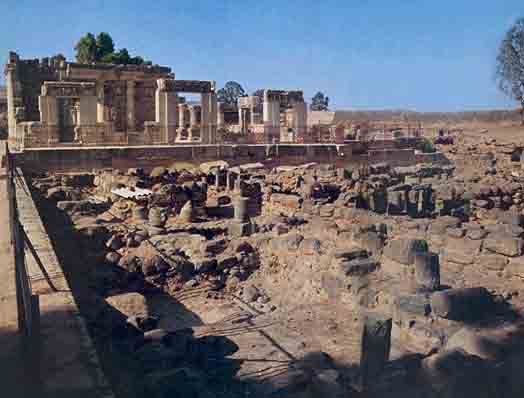
The first-century Capernaum synagogue in which Jesus preached has probably been found. Because more than one synagogue may have existed in Capernaum at this time, we cannot be sure that this new find was Jesus’ synagogue. But this recently discovered first-century building is certainly a likely candidate.a
At the moment, the synagogue is not a very impressive-looking structure, but it is there nevertheless. And for millions of Christians, that is the important thing. For Jews, too, this find adds important new evidence of how their people worshipped 2,000 years ago. Only a handful of such synagogues are known.b
At present, this ancient Capernaum synagogue has been only partly excavated. It may never be fully excavated and exposed because that would require dismantling the beautiful white limestone synagogue built several centuries later on top of the earlier synagogue.
Franciscan archaeologists initially exposed part of the first-century A.D. synagogue in the mid-1960s, but at that time the evidence was not clear enough for them to make the claim of its first-century date. More excavation was needed—this was undertaken in 1981. Now we have the evidence that was lacking.
The synagogue at Capernaum has been known since 1838 when the American orientalist Edward Robinson first explored and identified a number of beautiful architectural fragments in the ruins of Tell Hum, as the site was known locally, as the remains of an ancient synagogue.
Over the years, sporadic excavations exposed parts of the synagogue, but this prompted large-scale looting of the stones by local Arab building contractors. In 1894, the Franciscan Order purchased the site to prevent further depredations and even reburied part of the structure to protect it.
Naturally, much of the interest in Capernaum has stemmed from its importance in Christian history and its frequent mention in the Gospels. Shortly after John the Baptist baptized Jesus in the Jordan River, Jesus settled in Capernaum and made it the center of his ministry until he left for Jerusalem. The Gospel of Matthew (4:13) refers to Capernaum as Jesus’ residence.
The Gospels also tell us that Jesus preached and ministered in Capernaum and performed at least one miracle in the synagogue there (see Mark 1:21–25). Understandably, special archaeological attention has been focused on the building that was already identified as a synagogue.
From 1921 to 1926, the Franciscans, under the direction of Fr. Gaudentius Orfali, excavated the synagogue. Orfali dated the synagogue to the early first century A.D. It was, he said, the synagogue in which Jesus had preached. This dating, however, has been universally rejected as far too early.
Although Orfali’s dating was wrong, the synagogue he exposed and reconstructed was a jewel. Nestled on the shore of the Sea of Galilee and built of shimmering white limestone on a platform above a town built of rough black basalt boulders, the Capernaum synagogue is the most impressive synagogue unearthed in all of ancient Galilee. Flights of steps on either side of the platform give access to an imposing entrance facade with three doors facing Jerusalem.
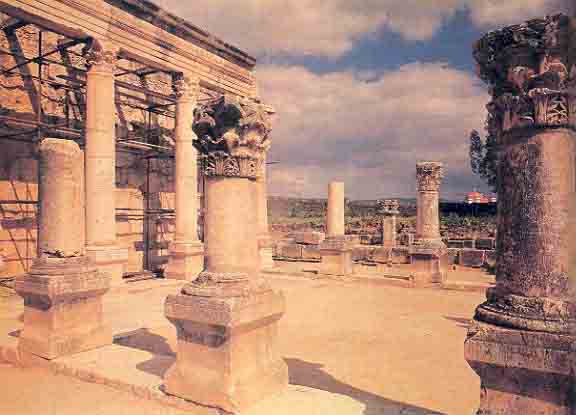
Inside the synagogue, along the two long walls, are stone benches, probably to seat the elders who governed the synagogue. The other worshipers sat on mats on the floor, eastern fashion.
Two rows of columns in the main prayer room separate a central nave from two side aisles. In the rear of the main room, a third row of columns creates a third aisle parallel to the back wall. A side room next to the main room served as a school, a court, a hostel for visitors, a dining hall, a meeting place. In antiquity, the synagogue usually included such an auxiliary “community center” room.
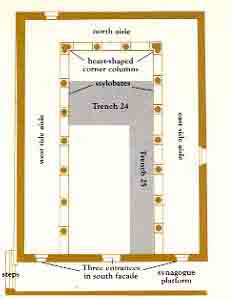
In 1968, the Franciscans renewed their excavations in the synagogue under the direction of two Franciscan fathers, Virgilio Corbo and Stanislao Loffreda.
These excavations touched off one of the most spirited debates in archaeological history—concerning the date of this beautiful ancient synagogue. On one point, all were agreed, however. This synagogue could not be the first-century synagogue in which Jesus preached. Israeli scholars contended that the building dated to the late second or third century A.D. The Italian excavators, however, contended that the building dated to the late fourth or early fifth century A.D.
The debate is fascinating because it involves archaeological, historical and architectural evidence—and each side seems to have a convincing case!
The Italians rely primarily on a hoard of more than 10,000 bronze coins they found under the pavement of the present synagogue building. As we have already noted, the present synagogue building was constructed on a platform created by the use of fill in order to give the structure a more monumental appearance. According to the Italians, a thick layer of mortar was laid on top of this fill, and the synagogue pavement was laid on top of the mortar. The Italian excavators found their coins in the fill and in the mortar which, they claim, sealed the fill below it. Some of the coins were actually embedded in the mortar. These coins have been dated to the fourth and fifth centuries and, according to the Italians, require them to date the synagogue building to the same period.
The Israelis, on the other hand, emphasize the artistic and stylistic parallels to the Capernaum building that clearly point to the end of the second or third century for its construction. That is when 20 or so stylistically similar synagogues were built in the Galilee and on the nearby Golan Heights. Moreover, this late Roman style is entirely different from the Byzantine synagogues with mosaic floors built in the late fourth and fifth centuries, sometimes within miles of the Capernaum synagogue. One such synagogue from the Byzantine period is at Hammath-Tiberias, only ten miles from Capernaum. As one Israeli scholar remarked, were these buildings in fact contemporaneous, “We would probably find this to be the only case of such astounding architectural diversity within so small an area.”
Even more important to the Israelis’ argument is the fact that barely 30 feet from the Capernaum synagogue, the Italian excavators found a relatively modest fourth-century church built over St. Peter’s House (see “Has the House Where Jesus Stayed in Capernaum Been Found?” BAR 08:06). It is surely unlikely, argue the Israelis, that so magnificent and richly decorated a synagogue as Capernaum’s would be allowed to be built so close to a church whose religion was now the state religion. As one Israeli scholar has commented, “Such a state of affairs might be conceivable in our ecumenical age, but it seems impossible to imagine that it would have been allowed by the Byzantine authorities of the fourth century.” No doubt there were synagogues built in the fourth century (probably by bribing local officials, because Byzantine law at the time forbade the erection of new synagogues), but all their splendor was reserved for the interior, not flaunted on the exterior, as was the case at Capernaum. To build a fourth-century synagogue so beautifully adorned on the outside—including the use of explicit Jewish symbols like the menorah, shofar, incense shovel, date palms (which symbolize Judea), lulav (the palm branch used during the Jewish festival of Tabernacles), and a representation of the paneled doors of the ark—would only emphasize the violation of the emperor’s law forbidding the construction of synagogues.
For all these reasons, most Israeli scholars adhere to the second- to third-century dating for the Galilean basilica-plan synagogues, including Capernaum.
But what of the coins “hermetically sealed,” as the Italian excavators put it, under the synagogue pavement? How did these coins dating from the fourth and fifth centuries get under the floor of a second- or third-century building? Perhaps, say the Israelis, the pavement was re-laid in the fourth century, at which time a fill could have been spread inside the building and a layer of mortar placed over it.
The outcome of this debate is still uncertain. If the Italians prove correct, it may require scholars to rewrite the history of the Jews in Palestine during the fourth and fifth centuries A.D. As we know the period today, it was one of persecution and decay, a time when Jews emigrated from the Holy Land instead of coming to it. A fourth- or fifth-century dating of the Capernaum synagogue would indicate that this was a period of prosperity and vigor, a time when Jewish life flourished.
In the midst of this debate a minor point in the Franciscan excavations went almost unnoticed—almost, but not quite.
In the course of their excavation, the Franciscans uncovered what seemed to be part of a wall under the limestone wall of the synagogue. This lower wall was built of worked black basalt blocks, without mortar. This same black basalt was used to construct the residential buildings that surrounded the synagogue, including the building the excavators identified as the first-century house of St. Peter.
In his preliminary report on the synagogue excavation, published in 1975, Corbo described this lower wall as a “foundation” of the south wall of the white limestone synagogue. In Italian, this lower basalt wall is called muro di basalto, Wall of Basalt. Corbo therefore labeled it “MB” in his notes—so this is what we shall sometimes call it and the similar walls related to it.
The excavators turned up this wall, or walls very much like it, in no fewer than six of their trenches. It stood to a height of about three feet. They found it beneath all four corners of the limestone synagogue in addition to the section they found beneath the south wall.
Then Corbo exposed this basalt wall for a length of 24 meters (78 feet) along the west wall of the synagogue—the entire length of the west wall of the synagogue.
There was something puzzling, however, about this black basalt wall that served as the foundation wall of the white limestone synagogue. At the southwest corner of the synagogue where the basalt wall appeared most clearly, it was out of alignment with the wall of the synagogue that rested on top of it. The MB or basalt wall extended almost a foot west of the southwest corner of the limestone synagogue wall. Why was this supposed foundation wall so clearly out of orientation with the wall it supposedly supported?
Corbo, ever the cautious scholar, refused to speculate. But in fact both Corbo and Loffreda suspected at a quite early stage that the MB or basalt wall may have been the wall of an earlier building, which was later used as a foundation wall for the limestone synagogue. The earlier building may itself have been a synagogue, perhaps from the first century A.D. More evidence was needed, however.
Even without additional evidence, a prominent Israeli scholar, Michael Avi-Yonah of Hebrew University in Jerusalem, suggested as early as 1967 that the MB (muro di basalto) might be the wall of an earlier synagogue.
Additional evidence was uncovered in excavations conducted by Corbo and Loffreda in 1981. The results have now been published in Italian.c
In the nave of the limestone synagogue, in the large central area between the two long rows of columns, two long excavation trenches were sunk in 1981 for the purpose of tracing the basalt wall beneath the limestone synagogue. Corbo’s first trench (trench 24) ran east-west across the nave. Originally, this area had been paved with limestone pavers used in the limestone synagogue. Beneath the pavers was a layer of mortar that still bore the imprint of the limestone pavers. Then the excavators slowly chipped away at a foot of mortar.
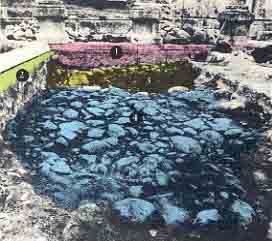
Below the mortar was a thin layer of limestone chips. These were the cuttings or debris left by the workers who cut the blocks for the limestone synagogue’s walls.
Beneath this thin layer was a fill more than three feet deep consisting of hammer-dressed basalt boulders mixed with dirt. This was the fill set in place by the builders of the limestone synagogue to create the platform on which the limestone synagogue was erected.
Nearly four feet below the surface, under the fill, the excavators hit a patch of rude cobbled pavement of black basalt. This patch was only ten feet long. On the patch of cobbled pavement were potsherds from the first to the fourth centuries A.D. The first-century pottery fixes the earliest date when the patch of cobbled pavement under the potsherds could have been laid.
At a point more than four feet below the nave of the limestone synagogue, the excavators found a pavement of basalt cobbles that extended throughout the entire length of the trench. Obviously, here was the floor of an earlier building. The pottery found in and under this cobbled floor dates to the first century A.D. or earlier. Loffreda published this pottery in extensive groups, and it clearly establishes a first-century A.D. date for the cobbled basalt floor.
At the end of the trench, the cobbled pavement ran up to black basalt walls that, Corbo immediately recognized, were identical to the black basalt walls he had found earlier.
The new basalt walls also appeared beneath the limestone synagogue’s stylobates. A stylobate is a special support wall for a row of columns necessitated by the additional load the columns bear. In the limestone synagogue there are rows of columns on three sides of the nave, creating two side aisles and a back aisle. Each row of columns has its own stylobate. The newly discovered basalt walls that the cobbled floor abutted were under the stylobates for the columns that created the side aisles in the limestone synagogue. These basalt walls served as foundation walls for the limestone stylobates. Originally, however, they were part of an earlier building.
The Italian excavators then opened another trench (trench 25) in the nave beside the eastern, limestone stylobate, extending for the stylobate’s entire length. The same stratigraphy (or layers) was found in this trench. The archaeologists found that the basalt wall ran almost the entire length of the eastern stylobate, serving as its foundation. This wall matched traces of the basalt wall found beneath the western stylobate.
It is now clear that the basalt walls beneath the limestone synagogue walls are the walls of an earlier building. True, they now serve as foundation walls for the stylobates and walls of the limestone synagogue. But they were not built as foundations. They were built as walls and stylobates of an earlier building and then reused as foundation walls by the builders of the limestone synagogue. This is the explanation for the fact that one of the basalt walls, as we pointed out earlier, is not in proper alignment with the limestone wall above it.
The consistent structure of the basalt walls (hammer-dressed boulders of uniform size, without mortar) in all the various places they have been found confirms that they all belonged to an earlier building.
There is another reason for this conclusion. As noted, beside the prayer room of the limestone synagogue is a colonnaded room that was probably used as a kind of community center. The entrance to this room is through the east wall of the synagogue’s main prayer room. Beneath this side room the excavators did not find any of the basalt walls they found under the prayer room. If the basalt walls had been built as foundation walls for the limestone synagogue, we would expect to find them under this side room of the limestone synagogue as well. The absence of basalt walls suggests that the walls under the prayer room, which were later used as foundation walls for the limestone synagogue, belonged originally to a structure that did not extend under the room beside the prayer room.
Another reason to conclude that the basalt walls were the walls of an earlier building stems from the treatment of odd gaps in the basalt walls. For example, there is a nearly five-foot gap in the basalt wall beneath the southern end of the eastern stylobate. The builders of the limestone synagogue needed a foundation here as well as under the rest of the stylobate, so they erected a column of mortar and stone on top of the remains of a floor at the bottom of the gap. In this way they provided support for the southern end of the eastern stylobate.
We can also conclude that this earlier building was not a private house but was, rather, a public building. This is clear from the fact that the basalt walls are nearly four feet thick. Only public buildings have such thick walls. Indeed, the walls of the limestone synagogue are only about 2.5 feet thick.
Moreover, with the additional material from the latest excavations, the plan of the earlier building has emerged with considerable clarity. It appears to follow quite closely the plan of the prayer hall of the limestone synagogue. The walls of the earlier building appear everywhere under the walls of the later building. Basalt walls were also found under the stylobates of the later building. In trench 25, which parallels the eastern stylobate, the excavators were able to follow the basalt wall under the eastern stylobate for a very considerable length. They found that this basalt wall did not extend all the way to the north or south wall of the limestone synagogue. In other words, the basalt wall under the stylobate stopped about where the stylobate of the limestone synagogue stops. This indicates that the basalt wall was, so to speak, freestanding in the earlier building, and may have been used to support an earlier stylobate, rather than enclosing a side room.
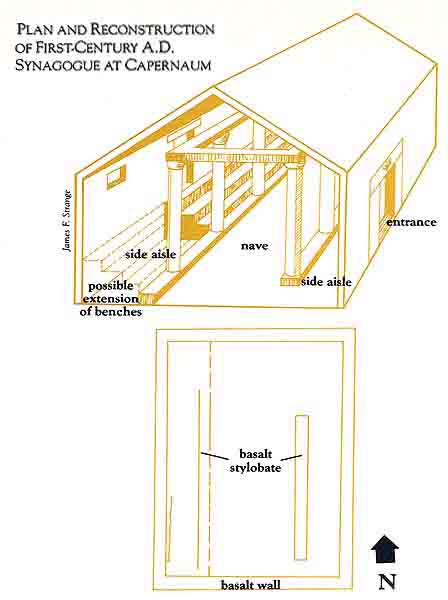
As shown in the drawing, based on parallels from other first-century synagogues, the excavators even assume that benches lined the side aisles of the basalt building.
No entrance to the earlier building has been located. However, there is a clear break in the basalt wall on the west side of the building between and beneath the second and third pilasters of the limestone synagogue wall; a door may once have been located here. Such an entrance is also suggested by the plan of a recently excavated synagogue at Magdala which is a parallel to the building we are examining, although much smaller. (The excavators call it a mini-synagogue.1) The Magdala plan also tends to confirm the accuracy of our reconstruction of the plan of the earlier building at Capernaum.
The date of this earlier building with basalt walls and a cobbled floor also seems clear. The pottery under the cobbled pavement dates from the third century B.C. to the latter half of the second century B.C. One of the coins found under the cobbled pavement was a coin of Ptolemy VIII Eugertes, who reigned from 146 B.C. to 117 B.C., although the coin may well have continued in circulation for some period after his death. On and in the cobbled pavement, the excavators found pottery sherds dating from the first century A.D. to the fourth century A.D.2 The floor was doubtless founded in the first century at the latest, and the basalt walls are clearly associated with this floor.
But is the earlier building a synagogue? The answer is yes, for several reasons.
Synagogues, and holy places in general, commonly remain in the same location. A new synagogue is customarily built over the remains of an old one. We know this from numerous excavations. Synagogue locations simply did not move around within an ancient town.
A famous pilgrim named Egeria traveled through Palestine from 381 to 384 A.D. and visited Capernaum at that time (see review of Egeria’s Travels to the Holy Land, Books in Brief, BAR 09:02). Peter the Deacon, writing in 1137 A.D., quotes from a copy of Egeria’s Travels no longer extant, except as quoted by Peter: “In Capernaum the house of the prince of the apostles [Peter] has been made into a church, with its original walls still standing. It is where the Lord healed the paralytic. There is also the synagogue where the Lord cured a man possessed by the devil [Mark 1:23]. The way in is up many stairs, and it is made of dressed stone” (V1.2). The Franciscan excavator Corbo believes Egeria was referring to the later, white limestone synagogue. Nevertheless, she attests to an ancient tradition even then that this was the site of the synagogue in which Jesus cured the demoniac.
The similarity of the plan of the earlier building to other ancient synagogues of the period also suggests that this earlier building was a synagogue. The plan of the earlier building is similar to the plan of synagogues found at Masada, Herodium, Gamla and Magdala, although, as the accompanying table shows, the earlier building at Capernaum was the largest of them—an indication of its importance.
| Synagogue | Width m/ft |
Length m/ft |
Area sq. m/sq. ft. |
% of Capernaum area |
|---|---|---|---|---|
| Capernaum 1st Century |
18.5/60.7 | 24.2/79.4 | 448/4838 | 100 |
| Magdala | 7.3/23.9 | 8.1/26.5 | 59/637 | 13 |
| Gamla | 15.4/50.5 | 19.4/63.6 | 299/3229 | 67 |
| Masada | 12.8/42.0 | 16.3/53.5 | 209/2257 | 47 |
| Herodium | 12.3/40.3 | 16.7/54.8 | 205/2214 | 46 |
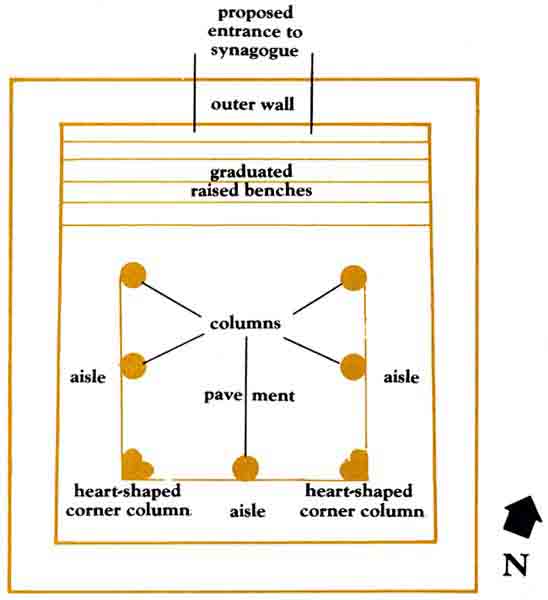
Architectural fragments that were probably used in the earlier building at Capernaum were found in the fill of the platform created for the limestone synagogue. These fragments are surely consistent with the identification of the building as a synagogue, even if they do not prove it. In the fill below the mortar of the later synagogue, the excavators found impressive column drums—one in beautiful gray granite—and fragments of two kinds of elegant cornice molding. All these fragments probably came from the earlier building and were reused as part of the fill creating the platform for the later building.
The conclusion that this was a first-century A.D. synagogue seems inescapable.
Corbo has concluded that this earlier building was the first-century synagogue in which Jesus preached. Luke 7:15 recalls certain Jewish elders from Capernaum who tell Jesus of a Roman centurion who “ … loves our nation, and built us our synagogue.” In his recent Italian publication, Father Corbo concludes: “This edifice, after thirteen years of patient labor of excavation and of recording, has been found appropriately under the area of the synagogue of the fourth/fifth centuries. We think therefore with all legitimacy that the edifice of basalt walls excavated under the synagogue is properly the synagogue constructed in the first decades of the first century by that Roman centurion of whom Jesus said, ‘Truly I say to you, neither in Israel have I found such faith’ (Luke 7:9).”
The first-century Capernaum synagogue in which Jesus preached has probably been found. Because more than one synagogue may have existed in Capernaum at this time, we cannot be sure that this new find was Jesus’ synagogue. But this recently discovered first-century building is certainly a likely candidate.a At the moment, the synagogue is not a very impressive-looking structure, but it is there nevertheless. And for millions of Christians, that is the important thing. For Jews, too, this find adds important new evidence of how their people worshipped 2,000 years ago. Only a handful of such synagogues are known.b At present, […]
You have already read your free article for this month. Please join the BAS Library or become an All Access member of BAS to gain full access to this article and so much more.
Already a library member? Log in here.
Institution user? Log in with your IP address or Username
Footnotes
The Gospels always speak of “the” Capernaum synagogue. Perhaps this was because there was one synagogue in Capernaum or the Gospel writers knew of only one synagogue. But it is also possible they said “the” because all their attention was focused on this synagogue.
Other first-century synagogues are known from Masada, Herodium, Gamla (probably), Magdala and perhaps Chorazim. In addition, an inscription from such a synagogue has been found in Jerusalem (see Hershel Shanks, Judaism in Stone, Biblical Archaeology Society and Harper and Row: New York and Washington, 1979, pp. 17–19).
Endnotes
Vigorous discussion in archaeological journals occurred when the Franciscan fathers Corbo and Loffreda first published their proposal for a fourth-century date for the white limestone synagogue at Capernaum (see Virgilio Corbo, Stanislao Loffreda, Augusto Spijkerman, La Sinagoga di Cafarnao dopo gli scavi del 1969, Franciscan Printing Press: Jerusalem, 1970). The announcement that fourth-century sherds were found on a first-century floor under four feet of fill and mortar is sure to generate even more debate.
